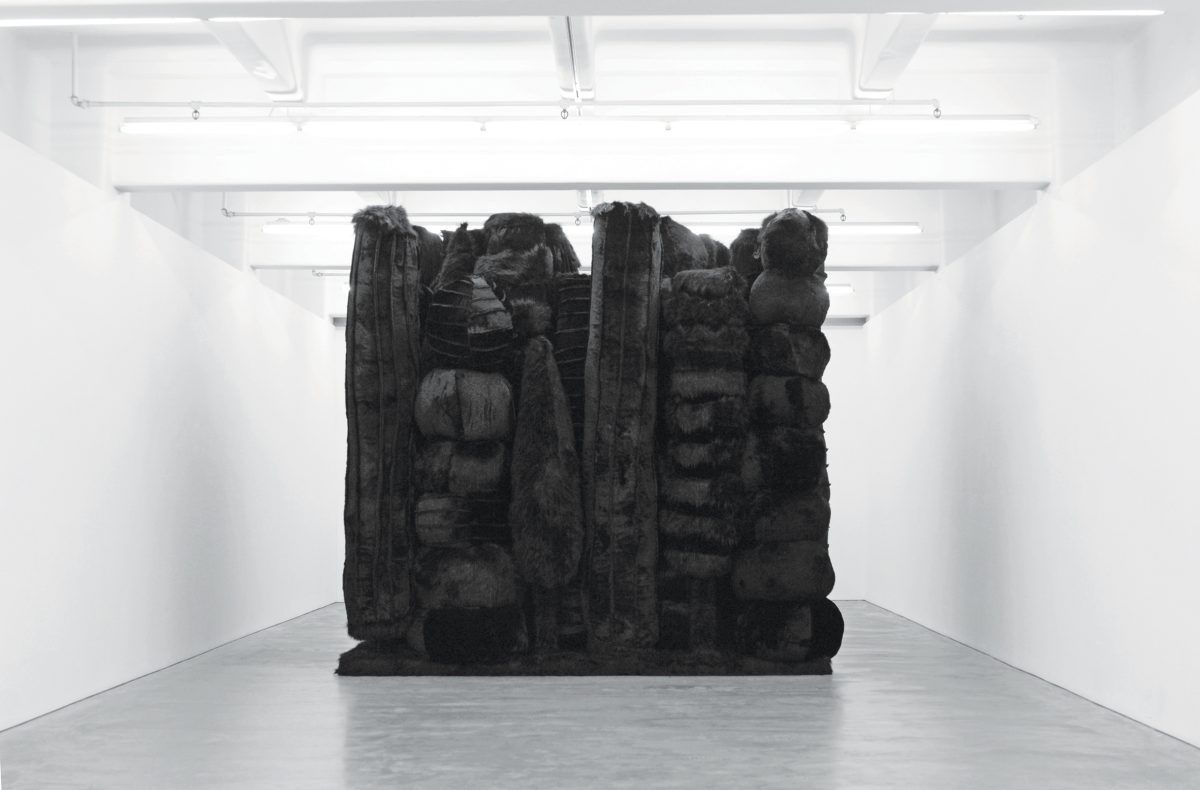Kathy Temin
My Monument, Black Cube
3rd September – 3rd October 2009
Anna Schwartz Gallery
The blackness of the fur trees in My Monument: Black Cube 2009 is evocative of both mourning and sexuality. The bleakness and beauty of black, its impenetrability, is so different from the immersive experience of walking through My Monument: White Forest 2008, currently on display in the survey exhibition at Heide Museum of Modern Art. My Monument: Black Cube 2009 is an object that is asking to be walked around: there is nowhere else to go. White Forest is imbued with optimism, as it is located against a Wedgwood blue backdrop whilst Black Cube is confronting, remote, dense and evocative. I have been interested in mourning jewelry, which has dense glossy surfaces that have a seductive materiality similar to my black and white glass pictures: Iconic Moments 2003.
I am the daughter of a Hungarian born Holocaust survivor and this has influenced my relationship to memory, history and loss. However the aim for My Monument: Black Cube 2009 is to engage with both private and collective ways of marking the memory of a person or event, an engagement not limited to a particular history or event. I have done this through making repeated forms in the unconventional material of synthetic fur that invokes the emotional content in soft toy imagery. The trees are anthropomorphic through their large scale and physicality.
I am interested in the relationship of the viewer to the object; something that has been highlighted for me through looking at and experiencing the forms and materiality of the work of both Eva Hesse and Richard Serra. With Hesse it is the combination of abstraction with emotion, through repeated forms and references to the abject body. With Serra it is a sense of fear and claustrophobia that the scale and heaviness of the material evokes for me.
When I visited the concentration camps in Europe I felt physically very small within these vast spaces that are surrounded by beautiful tree-lined countryside. I wanted to create an object that combined that feeling of smallness with the comfort and protection of the softness that the fur evokes. I am looking at this cube and at various landscapes and gardens with their possibilities for metaphor and contemplation; at notions associated with grief and loss, and with hope and faith.
There are other artists who have approached the idea of the monuments: Sol Le Witt’s Monument to the Missing Jews 1988/1989 in Hamburg-Altona, Germany, a large black rectangular form, originally commemorated the missing Jewish community of Münster. Jochan and Esther Shalev-Gertz’s disappearing steel column, Monument Against Fascism 1986 – 93 in Hamburg-Harburg Germany, was located close to a suburban shopping center and lowered into the ground over a period of seven years. It involved passers-by who wrote their names in lead on the column as a petition against fascism.
When participating in a walking tour of the Jewish area in Berlin in 2009 I came to appreciate that the city itself was a living, active monument to the people that never returned to their homes. The reminders of the past are part of the everyday urban environment with small gold memorial tiles embedded into pavements that mark specific locations where lost individuals or families once lived. Peter Eisenman’s Holocaust Memorial in Berlin is contemplative and thoughtful through the use of thousands of black concrete plinths of varying scales with paths that viewers can walk through, placing the audience inside the work and generates an immersive experience over a vast area. Rachael Whitread, Doris Solcedo and Mona Hatoum’s projects have been influential for me for their reflections of both private and collective histories and memories where the presence of absence is evoked through the work.
These works and artists have contributed varying ways for me to think about what might constitute a memorial, a monument; taking it beyond narrative or literal form. Making My Monument: Black Cube has allowed me the space to reflect on how artists can contribute to the placement of private thoughts in public spaces.
This text has been extracted from and has extended upon an interview with Andrew Renton, “Running past a Richard Serra” in Kathy Temin, Heide Museum of Modern Art, 2009
The artist would like to thank: Arts Victoria, The Australia Council, Lenni Morkel-Kingsbury, Angela Thirlwell, Jeph Neale, Andrew Renton, Jason Smith, Sue Cramer and Rebecca Renshaw at Heide Museum of Modern Art and Kit Wise and Kathie Barwick at Monash University, Caulfield.
Images

Kathy Temin
My Monument: Black Cube, 2009
synthetic fur and filling, wood, steel
355 x 370 x 370 cm
installation view, Anna Schwartz Gallery
